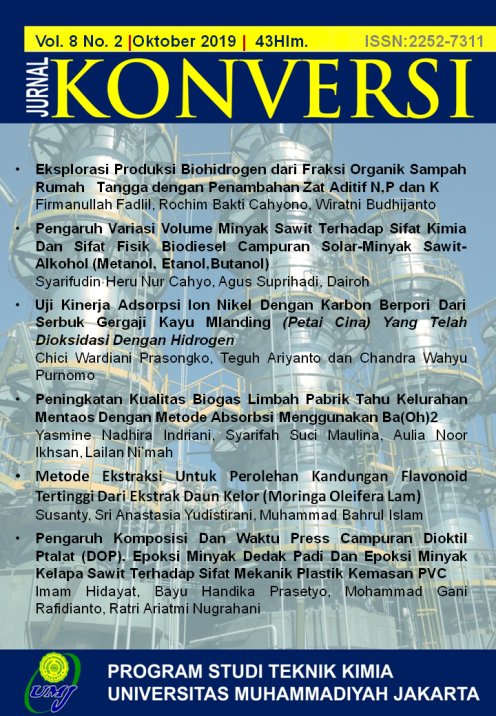UJI KINERJA ADSORPSI ION NIKEL DENGAN KARBON BERPORI DARI SERBUK GERGAJI KAYU MLANDING (PETAI CINA) YANG TELAH DIOKSIDASI DENGAN HIDROGEN
Main Article Content
Abstract
Penelitian ini dilakukan untuk mempelajari perubahan gugus fungsi dari karbon berpori yang disintesis dari serbuk gergaji kayu mlanding atau petai cina setelah dioksidasi dengan H2O2 pada variasi suhu 30°C, 60°C, dan 80°C. Selain itu, penelitian ini juga dilakukan untuk mempelajari pengaruh karbon berpori setelah dioksidasi terhadap adsorpsi ion nikel. Percobaan adsorpsi dilakukan dengan menggunakan larutan Hexammine Nickel (II) Nitrate [Ni(NH3)6](NO3)2 yang disintesis dengan cara menambahkan Nickel (II) Nitrat Heksahidrat (>99,9%, Merck) ke larutan Ammonia (25wt%, Merck). Larutan nikel digoyang selama 48 jam dengan menggunakan shaker waterbath pada variasi suhu yaitu 30°C, 40°C, dan 60°C. Hasil penelitian ini menunjukkan bahwa oksidasi karbon berpori akan meningkatkan gugus fungsi dalam karbon berpori seperti lakton, karboksil, dan fenol. Untuk adsorpsi ion nikel oleh karbon berpori dari serbuk kayu mlanding mengikuti pola isotherm Langmuir dan menunjukkan kinerja yang lebih baik untuk menjerap ion nikel dalam larutan dibandingkan dengan karbon yang tidak teroksidasi.
Article Details
Issue
Section
Articles
Authors who publish with this journal agree to the following terms:
- Authors retain copyright and grant the journal right of first publication with the work simultaneously licensed under a Creative Commons Attribution License that allows others to share the work with an acknowledgement of the work's authorship and initial publication in this journal.
- Authors are able to enter into separate, additional contractual arrangements for the non-exclusive distribution of the journal's published version of the work (e.g., post it to an institutional repository or publish it in a book), with an acknowledgement of its initial publication in this journal.
- Authors are permitted and encouraged to post their work online (e.g., in institutional repositories or on their website) prior to and during the submission process, as it can lead to productive exchanges, as well as earlier and greater citation of published work (See The Effect of Open Access).
